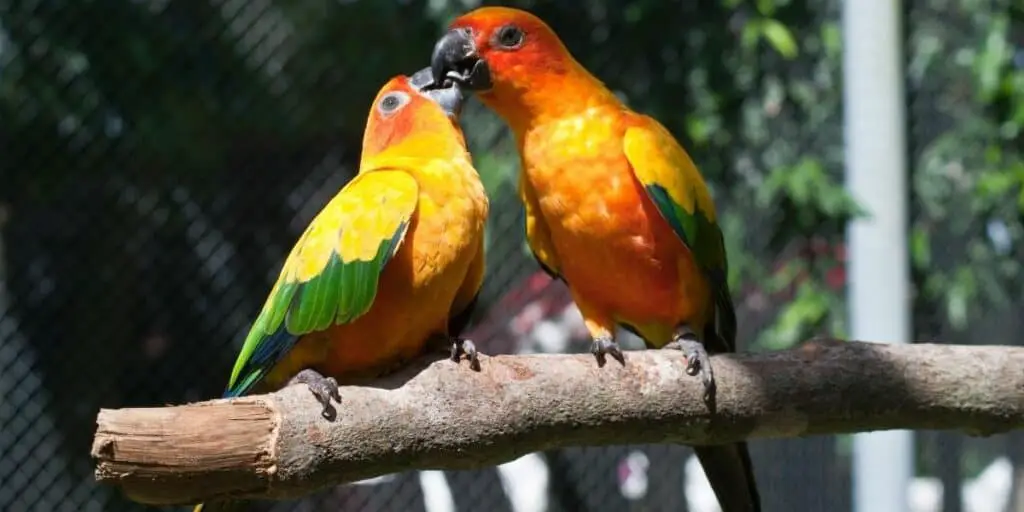Parrots are animals. Like all animals, they have needs biological, physical and sometimes reproductive.
There are several factors that lead to a parrot becoming attracted to a mate, including plumage and personality.
When parrots mate, it is slightly different to most animals of their kind. Male parrots will deposit ejaculate into their mate by an opening in their cloaca which deposits into the open female cloaca.
The fertilizing agent then travels through the oviduct tubes into the ovaries where it combines with an ovum.
After this, several other processes occur to form a fertilized egg, which is then laid by the female parrot.
This article will comprehensively break down the steps in this process. Alongside this, it will also consider some frequently asked questions revolving around the results of parrot mating.
So, if you are interested in exactly how parrots mate, are concerned about your parrot’s mating habits and behaviors, or want to know if it will affect your parrot’s health: read on!

Table of Contents
How do parrot eggs get fertilized?
During the beginning of the mating seasons, a parrot will find a mating partner. After they select their partners, the birds get down to business.
This is remarkably like other animals of its type, but parrots and other birds have one crucial difference: internal genitalia.
As such, it can be exceedingly difficult to tell when exactly your birds are mating.
When moving to fertilize a female parrot, the male parrot will mount the female and begin mating.
The internally stored cloacae of the two creatures are aligned, and then the male’s internal testes will drop sperm through the matched cloacae into the female oviduct tubes.
Once the sex has concluded, fertilization occurs within the female. Once an ovum is fertilized, it is joined with a yolk sac.
After this combining, the ovum and yolk travel together through an oviduct tube and down to an area in the female parrot where the hard shell is formed.
The shell is a brilliant act of biology, with a perfectly engineered shell that is both brittle enough to be broken by the baby parrot and hard enough to protect and incubate it.
It is also hard enough to survive the laying process and shows just how brilliant the natural world is at creating things that are perfect for their jobs.
What do parrots look for in a mate?
So, now we know how parrots mate. But we are left wondering: “what comes before that?” How does a parrot express attraction, and how do they select their partners for mating?
It might seem obvious to most that the parrot’s gorgeous, beautiful plumage and their wide array of colors would be a natural way to select mates.
However, studies have found that parrots are over 75% sexually monomorphic – meaning that physically there are no apparent differences between males and females of a species.
So, if a parrot probably does not really care about plumage color, do they not care about their mate’s feathers at all?
It has been found that alternatively, a lot of parrots look for intensity of feather color as a sign of a good mate.
A strong, bold color scheme in a parrot’s feathers signals an array of positive qualities in a mate: breeding success, parental capabilities, disease immunity and good solid health.
Studies into the Burrowing Parrot of Argentina show that the more intense, the bolder the red feathers on a parrot were, the more success they had in finding a mate and breeding.
Some mating partners do not value just looks, however. In the kakapo species of parrot, male suitors will go and compete by creating the best kind of indentation into the ground. They call the females over and are selected based on their soil sculpture talents.
Budgerigars are often invested in singing though, but not just in vocal volume or flexibility. This bird subspecies in particular look for partners whose call sounds like theirs.
Why do my parrots look angry when they mate?
If you see alarming amounts of flapping and calling when your parrots mate, then do not be too concerned. A male parrot flaps its wings during mating to maintain the delicate balance and position required to transfer sperm through the respective cloaca’s.
Can parrots lay eggs without mating?
Yes, and you should not be too concerned if they do! Eggs are often produced by female birds (and parrots) in response to changing light patterns that occur during the close of the winter season.
It is a sign that temperatures are beginning to warm, and that the “breeding season” for the parrots is beginning to arrive.
As the year begins to heat up, the parrot’s biology registers that the weather is getting suitable for incubation of young chicks. Then, an egg is naturally produced.
Eggs do not necessarily contain a baby parrot; they just demonstrate a place that a baby parrot could have been in.
So, yes your parrot can lay eggs without mating, and you should not assume your parrot has mated just because of its egg production
Can laying eggs be bad for my parrot’s health?
Not necessarily. It is true that eggshells are formed using your parrot’s own sources of calcium, and that excessive egg laying can cause calcium deficiency.
If you are worried about this in your bird, you should contact a veterinary professional. Vets will often recommend calcium supplements in cases like this, or specific feed that provides more calcium.




